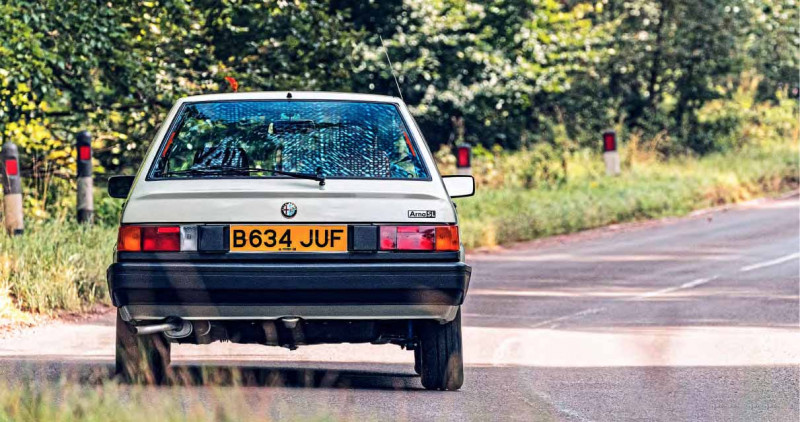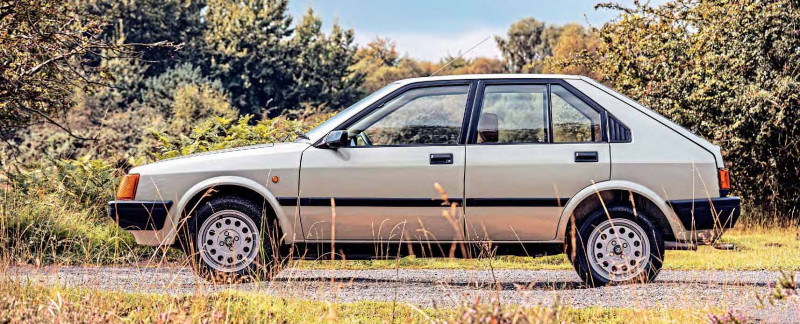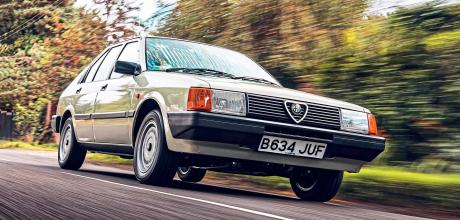1985 Alfa Romeo Arna 1.3SL
Alfa Romeo’s Arna is considered to be the worst car ever to wear the badge, but does it deserve its bad reputation? We drive a restored survivor to find out.
Words SAM DAWSON
Photography ALEX TAPLEY
Alfa Reviled?
Worst car to wear the badge, or surprising saviour? Driving the Alfa Arna

Should I be enjoying myself as much as this? A broad grin is breaking across my face as I flick a slickshifting gearlever into another ratio, attack another rural Staffordshire bend, feel the unassisted steering communicate with my fingertips as the nose grips the tarmac, and hear the crackle of a Dell’Orto carburettor and roar of a thoroughbred Italian boxer engine. My vision is framed in a gorgeous shade of metallic mint green that wouldn’t look out of place on an early Lamborghini Countach. And yet I’m driving an Alfa Romeo Arna. Yes, an Arna; one of those handy go-to cars to give a kicking to if a journalist fancies drawing up a ‘world’s worst-ever cars’ list. Jeremy Clarkson – coiner of the infamous ‘you can’t call yourself a proper petrolhead until you’ve owned an Alfa Romeo’ trope – once blew one up with a grenade in his first non-Top Gear VHS release to make a puerile point. ‘Italian style with Japanese build quality? No, this was a Nissan Cherry with Alfasud electrics,’ he quipped as the rare survivor behind him detonated. Passionate Alfisti claim it isn’t really an Alfa at all. You’re lucky if marque history books include a single photo of one.

Yet it certainly feels like an Alfa on the road. And this one isn’t even the hot Ti version you may have thought would salvage some respect through spoilered grunt in the face of mediocrity. It’s the mid-range 1.3SL. And it’s not the slightest bit mediocre. The story behind the Arna seems to be well-known but not particularly well-understood. In 1982 Alfa Romeo was – not for the first time – in deep financial trouble. Under the control of the Istituto per la Ricostruzione Industriale (Institute for Industrial Reconstruction), an Italian government-run body that took command of struggling manufacturers until buyers could be found, it had quietly signed a memorandum of understanding with Fiat to share components and jointly develop cars in future. But Alfa Romeo had just been forced to lay off 5078 workers to stay afloat. The mainstay of its range, the Pomigliano d’Arco-built Alfasud, was a decade old and plagued with widely reported build-quality problems.
‘It reminds me of the much more modern BMW-reinvented Mini’
Alfa needed a new small car, and quickly. Preferably one it didn’t have to provide bodyshells for, because most of the employees who’d been laid off were metalworkers. In Japan, Nissan had issues too, of an entirely different kind. Its cars had the opposite reputation to Alfa’s – reliable and well-made, but dull to drive and look at. In the wake of shoddy Seventies European build quality, dull-but-worthy sold well. However, in Europe Japanese imports were strangled by protectionist agreements with various governments, limiting the numbers of Japanese cars that could be sold per year. If Nissan could build its cars in Europe, it would circumvent the issue.

Nissan’s Sunderland plant would turn out to be the most enduring result of this, but the short-lived Alfa Romeo Nissan Autoveicoli (ARNA) was another. It features the bodyshell, rear suspension and dashboard of the Cherry, but everything else is Alfa, including front suspension and steering shared with the larger, then-new 33, characterful flat-four engines carried over from the superb-but-fragile Alfasud, and an attempted restyle via different light clusters, grille, seats and steering wheel.
Alfa purists won’t want to hear me say this, but it’s a blend that – certainly in the context of 1985, when this car was built – works. The seats look stylishly Italian, but they conceal the endless adjustability typical of Japanese world-car design, and the result is the first flat-four Alfa I don’t have to drive with my knees touching my knuckles. The angular dash has a retro-cool ambience, now that everyone’s forgotten what a Nissan Cherry’s looked like, and the oval dials are reminiscent of a Citroën SM’s. And it’s all lifted by that steering wheel with its drilled spokes, dated in a plasticky Eighties world but feeling like a link to a time when Alfa Romeo was a byword for compact GTs driven by motor sport enthusiasts in open-knuckled leather gloves.
Although it’s all forgotten in the name of cheap jibes nowadays, it seems Alfa knew this too. Throughout the Arna’s life it was sold alongside, and shared its powertrain with, the gorgeous Sprint coupé. Owner Ian Jephcott shows me a rare period brochure packed with Arna-branded accessories. Some look like cheap nicknacks now – pens and keyrings – but they’re designed in that Italian-modernist plastics-industry idiom, colourfully eye-catching like an Olivetti Valentine typewriter. But other branded items in the catalogue seem more serious and poignant somehow. Umbrellas, Italian designer clothing, matching luggage, a programmable LED digital readout to showmessages to other motorists from the parcel shelf, and even a two-bottle presentation box of Arna edition Malvasia secco wine all smack of a keenness to stress the Arna’s Italian pedigree. They also hint at a life of glamorous grand-touring adventure.
Taking all this into account, the car that the Arna is increasingly reminding me of is something much more modern – the 2000-on, BMW-reinvented Mini. It too was accused of supposedly hailing from a different country and cynically cashing-in on a much-loved brand. But Mini also knew how marketing could be used to elevate a basic supermini above the white-goods status of its competitors. Practicality was a given, but play on people’s heartstrings, make them feel as though their car is something more special than mere basic cheap transport.

And make it fun rather than dull to drive as well. When you bear in mind the Arna’s market, this mentality seems way ahead of its time. This was a £4470 car when new, making it a direct rival to the Fiat Uno. But in terms of size it was on a par with the Ford Escort MkIII. While it seems fashionable to lambast the Arna as a rebadged Cherry nowadays, its boxy angularity was hardly unusual in the context not only of its rivals, but its stablemates too. Only Alfa’s sports cars flauntedcurves – the 33, 75 and range-topping Six were all squaredoff brutalists just like the Arna. Lined up alongside other Alfas, had you never seen a Cherry and were told the Arna had been dashed off by a junior Pininfarina stylist, you’d believe them.
I’m not alone in enjoying the Arna. Period road tests are full of praise for it. Motor Sport’s Bill Boddy – a self-styled irascible purist if ever there was one – felt platform-sharing was logical and not to be shunned, before revealing that he’d managed to beat Alfa’s claims of the 1.3SL’s sub-100mph top speed, and praising its driving position, luggage space, the clarity of its dashboard, and keen handling. Autocar and Motor liked their Arnas too. CAR called it a ‘serious contender’, and better than the big-selling new Austin Maestro. The performance of the hot Ti version was on a par with the £2k-dearer Fiat Strada Abarth 105TC. Interestingly, especially at a time when the dearer Alfa 33 was racking up a reputation for build-quality issues, all period reviews praise the Arna’s build quality as something Alfa had learnt from Nissan.
So, what went wrong? Yes, there was some fury from Alfisti who lamented the arrival of platform-sharing at their once thoroughbred marque – presumably having forgotten the Renault Dauphine-based Onedine of the early Sixties – but it seems industry, as much as reputation, may be at fault when it comes to damning Alfa’s bold experiment.
As well as Arnas, Nissans were built at Pomigliano d’Arco; they were badged Cherry Europe, to be sold in Spain and the UK. Nissan dealers were used to their Japanese-built cars being so well-built as to not require pre-delivery inspection (PDI), but as Cherry Europes – excellent for an Alfa, but often below Nissan’s par – arrived in showrooms, they needed an unprecedented level of pre-sale fettling. Word got around and sales of both Cherry Europes and Arnas slumped. There was also the sense that Alfa Romeo Nissan Autoveicoli was only ever intended to be a stopgap. It only produced one other vehicle – the Romeo van-based Nissan Trade – before IRI sold Alfa to Fiat in 1987, banishing Nissan production from Italy for good. And with Sunderland up and running, Nissan didn’t need Pomigliano any more anyway.
But there is something significant about the Arna in retrospect that, again, Alfisti won’t like. It set a template for modern Alfas that the brand still follows today. Ever since the Arna, every mass-produced small Alfa has shared its underpinnings with a Fiat, Lancia or – in the case of the new Tonale – a Jeep. What makes them Alfas lies in craftsmanship – styling, engine tuning, bespoke suspension, marketing. So, everything the Arna pioneered, then. For a car so reviled, it feels like it is owed a debt of gratitude.
TECHNICAL DATA 1985 Alfa Romeo Arna 1.3SL
- Engine 1351cc horizontally opposed four-cylinder, sohc per bank, Dell’Orto FDRA 32G carburettor
- Max Power 71bhp @ 5800rpm
- Max Torque 77.4lb ft @ 3000rpm
- Transmission Five-speed manual, front-wheel drive
- Steering Rack and pinion Suspension Front: independent, MacPherson struts, lower links, coil springs, telescopic dampers. Rear: independent, trailing arms, coil springs, telescopic dampers
- Brakes Discs front, drums rear, servo assisted
- Performance Top speed: 100mph; 0-60mph: 12.2sec
- Weight 853kg
- Fuel consumption 32mpg
- Cost new £4620
- Classic Cars Price Guide £5000
Still displays the panache that impressed period road-testers Slick five-speeder plays its part in making the Arna a fun drive Italian style, with Japanese adjustability Dash is pure Sunny, steering wheel pure Alfa.
Did boxy Nissan Sunny body get an unfairly bad rep? Light cluster design is bespoke to the Arna.
Angular plastic dash has a retrocool appeal.
‘It reminds me of the much more modern BMW-reinvented Mini’
Characterful flat four also powered the Alfasud.
OWNING AN ARNA: IAN JEPHCOTT
Ian Jephcott restores Alfas professionally – you may remember seeing his Berlina in a past Epic Restoration – but he has a soft spot for the Arna, which led him to lavish the same attention on this example. ‘I acquired it from a friend – it had been rusting away in a garage but I just had to have it,’ says Ian. ‘I knew that once restored it’d be the only mid-range five-door Arna on British roads – most of the examples saved have been 1.5Tis. ‘Alfa actually altered the internal Cherry structure to accommodate its parts, so it’s not just a badgeengineered Nissan. It complicated restoration because you can’t just use more common Nissan parts – in fact, some “Arnas” on the road are actually Cherries passed off as Alfas with grilles and badges… ‘I set up the Arna Register of the Alfa Romeo Owners’ Club. They have a growing number of fans now, often people who wanted an Alfasud but found them out of their price range. They really aren’t bad cars – a lot of the people who write them off as a kind of Italian Austin Allegro have never seen one, let alone driven it.’


